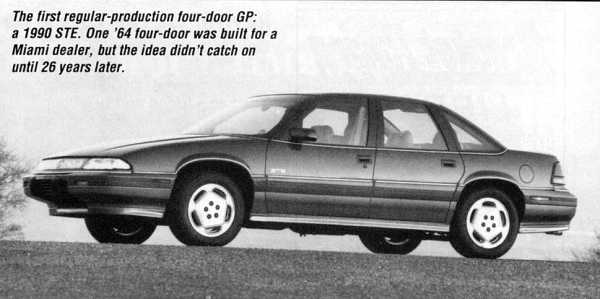1989
For 1989, Pontiac added a couple of engines to the GP lineup. As a midyear introduction, a stroked 3.1-liter version of the 2.8 V6 was implemented, but coupled only to an automatic. The larger engine developed 140 hp at 4800 rpm, with 180 lbs.-ft. of torque at 3600.
Also available only with an automatic transmission was the Grand Prix Turbo, which actually was not just an engine option, but a limited-production car that could truly be called the first high-performance Grand Prix since the demise of the 455 SJs. It differed from lesser models in quite a few areas.
The engine was developed by ASC/ McLaren for use exclusively on this car. While the block and bottom end were the same as the normally aspirated versions, they were "hardened selected castings" with more rigid quality-control standards than normal. The turbocharger was the Garrett T25 model. The water-cooled turbo blew into an air-to-air intercooler on its way to the multi-point fuel-injection system.
The modifications were good for a very respectable 205 hp at 5200 rpm, with 225 lbs.-ft. of torque at 2400. Maximum torque was actually governed by the computer to avoid overloading the beefed-up automatic transaxle. ABS was standard—a GP first.
The body received revised front and rear fascia panels, as well as larger side skirts to accommodate the 245/50ZR-16 Goodyear Eagle Gatorback radials, which were mounted on gold cross-lace 16x8-inch wheels.
The exterior revisions definitely gave the GP Turbo an aggressive and distinctive look, which it could back up. Zero-to-60 times were in the low 7-second range, with quarter-mile times in the mid-15s at around 90 mph.

1990
When the 1990 GPs rolled into the showrooms last fall, a lot of reshuffling had occurred. A new four-door body style was added to the roster, and the base Grand Prix coupe had been dropped. The new lineup went as follows: an LE coupe and sedan, an SE coupe, an STE (Special Touring Edition) sedan and the limited-edition Grand Prix Turbo coupe.
A new engine was added to the list of offerings, too—the 2.3-liter Olds-designed Quad 4. It was available only with the 3-speed automatic transmission, and developed 160 hp at a rather buzzy 6200 rpm. with 150 lbs.-ft. of torque at 5200.
While the LE four-door was quite similar in appointments to its two-door counterpart, the new STE sedan represented an expanded view of what a GP is all about. After 28 years, the luxury-performer concept had been expanded to include a four-door interpretation.
Up front, the STE got unique front and rear fascias, with integral fog lamps across the width of the nose, a la Mercury Sable. The rear sported full-width taillamps. Inside, the STE had an analog dash similar to the Turbo's. The STE was also the recipient of specific, articulated bucket seats. In most other respects, the STE's interior was like the Turbo's.
The STE's base engine is a 3.1-liter V6 hooked to a 5-speed manual trans, with a 4-speed automatic optional. Also optional is the 3.1-liter turbo engine. While the STE has the same suspension calibrations as the Turbo, it uses smaller P215/50R-16 Goodyear Eagle GT+4 radials on specific 16x6-inch wheels.
What's on the horizon for the next batch of Grand Prixs? The Turbo is gone for '91. In its place will be the Grand Prix GTP, looking similar to the Turbo but powered by a 3.4-liter double-overhead-cam V-6 developing well over 200 hp and normally aspirated. We're also looking for an all-new GP for 1993.
While the history of the Grand Prix has been, for the most part, a glorious one, there have been some low points. Fortunately, things are on the upswing, and we can look forward to even more Pontiac Excitement! 
|
|